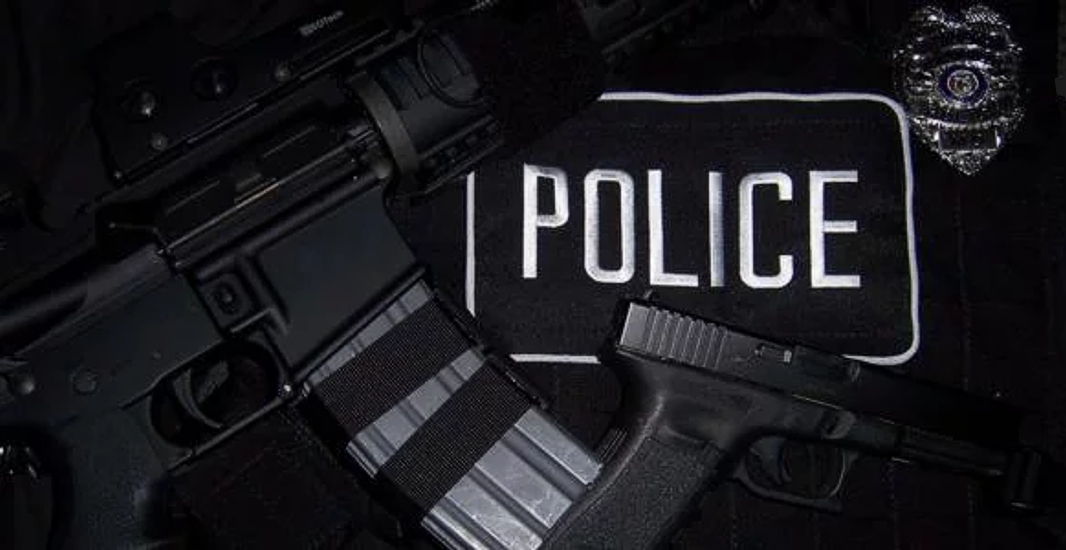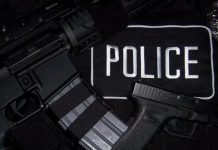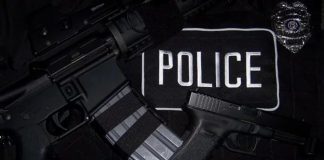On April 5, 1970, the officer survival movement was born out of one of the darkest days in law enforcement’s history. In less than five minutes, two heavily armed and well-prepared criminals shot and killed four California Highway patrol officers.
These officers were from an agency that was believed to be one of the leaders in police training.
Today the lessons learned from the blood of fellow officers involved in the California Newhall Incident are taught in almost every police academy in America.
The incident started as Jack and Pamela Tidwell were driving in rural Newhall, California, and a red Pontiac hardtop swerved across the median into the path of their Volkswagen, cutting them off. The red Pontiac pulled to the roadside and a furious Jack Tidwell, pulled up next to the Pontiac.
Mrs. Tidwell rolled down her window so her husband could give the offending driver a piece of his mind, and he yelled that he had taken the careless driver’s tag number down and was going to report him to the Highway Patrol. Mr. Tidwell then told the driver of the Pontiac that he would like to “kick his ass”.
The lone driver of the Pontiac smiled and called Mr. Tidwell a punk and then raised a .38 snub nose into clear view and pointed it at him. Mr. Tidwell stammered that the Highway Patrol was right behind them.
The driver of the Pontiac looked into his mirror and saw a truck approaching.
Mr. Tidwell put his car into gear and raced away to find a phone to call the police. It took Tidwell fifteen minutes to find a pay phone to call the Highway Patrol.
California Highway Patrol Officers Walter Frago and Roger Gore received the call and set up a stakeout position on the route they anticipated the red Pontiac would take.
At six minutes before midnight, dispatch received a radio message that Officers Frago and Gore had located the red Pontiac, now with two occupants, and were in position behind it.
Officers James Pence, Jr. and George Allen radioed in they were enroute to backup Frago and Gore.
The red Pontiac turned onto Henry Mayo Drive from route 99 and headed for a Standard gas station next to a popular truckstop called Jay’s Restaurant.
Inside the Pontiac was Jack Twining, 35, with a 20-year history of crime including bank robbery, who was on parole at the time for assault on police with deadly weapons, and Bobby Davis, 27, who, with an equally long criminal record, had often boasted that he hated cops and would rather kill one then go to prison again.
Davis and Twining observed the black and white California Highway Patrol car pull in behind them and then begin to follow them. Both criminals knew that their freedom would not survive a car stop because they had been planning to stage a series of bank robberies and had been out target practicing with numerous weapons and also testing new two way radios to see how far they would transmit and receive earlier that afternoon. That was the reason why Twining had not been with Davis during the Tidwell incident.
Davis and Twining, both felons, knew that the arsenal of guns they had with them in their car was enough for the police to send them back to prison for a very long time. Davis and Twining at this point agreed that if they got any chance at all, they would shoot down the officers rather then go back to prison.
The criminals arsenal of guns included a Smith and Wesson Model 39 9mm auto, a six inch Colt Python .357magnum, two snub-nosed Colt .38 revolvers, a 1903 Springfield .30/06 bolt action military rifle, a Remington Model 572 .22 pump action rifle, and a Ruger .44 magnum semiauto rifle carbine which was in a jammed condition in the trunk of the Pontiac.
Inside of the car, Davis and Twining had two stolen Colt 1911A1 .45 automatics and a 12 gauge pump sawed-off shotgun in the back seat.
Davis had the Smith and Wesson .38 special snub-nosed revolver with which he had terrorized the Tidwells tucked into his waistband.
Twining had a Smith and Wesson Model 28 .357 magnum in the front seat sitting next to him.
Officers Frago and Gore reported to dispatch that the red Pontiac had pulled into the parking lot of Jay’s Restaurant and had stopped. The red Pontiac stopped approximately 100 feet from the restaurant that had about 30 customers inside.
The lighting was good in the restaurant’s parking lot making it easy for witnesses to see the unfolding events.
Officer Gore pulled the patrol car in behind the red Pontiac in a felony stop position. Both officers got out of the patrol car and Gore drew his .357 magnum service revolver and took up a cover position behind the driver’s door. Frago had a Remington model 870 pump shotgun and moved to cover behind the right fender of the patrol car.
Gore ordered the suspects out of the car three times before finally Davis slowly got out of the driver’s side of the Pontiac.
Gore positioned Davis at the left rear of the Pontiac standing with his feet wide apart and his palms outstretched against the car while Twining was still sitting in the front passenger seat.
Gore began to search Davis while Frago approached the passenger side door where Twining was sitting.
Fargo reached to open the car door, but to do this he had to take the shotgun off of Twining. So Frago raised the barrel up off of Twining, placed the butt of the shotgun on his hip, and attempted to open the car door.
This was the opportunity that the criminals were waiting for and Twining took advantage of it by shooting officer Frago twice in the chest with his .357 magnum, killing him instantly.
Gore, who had reholstered his revolver while searching Davis, drew his service revolver and fired at Twining who returned fire.
Davis took advantage of the fact that Gore was occupied with Twining and drew the .38 special snub-nosed revolver out of his waistband, twice shooting Gore in the right side of his chest, killing him.
As Davis was shooting Gore, Officers Allen and Pence were arriving on the scene.
Davis and Twining were ready for them. Davis and Twining emptied their revolvers at the oncoming police car. Officer Pence was pulling parallel with the rear of Gore and Fargo’s squad car when the criminals bullets hit.
Pence barely had enough time to send out a breathless radio message that they were under fire. It was the first notice that dispatch had that something was wrong.
Davis and Twining discarded their empty revolvers and headed toward the Pontiac to retrieve the weapons they had in the backseat. Davis found the sawed-off shotgun and Twining got one of the Colt .45 automatics.
Twining then took a shot at the police cruiser and when his pistol jammed, threw the jammed pistol back into the Pontiac without even trying to clear the jam and grabbed the second Colt .45.
As the squad car came to a halt, Allen jumped out and started to fire at Davis and Twining with his Remington 870 shotgun while maneuvering up to the first patrol car, taking cover behind the open right front door.
Pence took cover behind the driver’s door and fired his service revolver at Davis and Twining.
Allen only managed to hit Twining once in the center of his head with a single stray pellet from his shotgun. Unfortunately, the pellet had lost too much velocity going through the Pontiac’s rear window and didn’t penetrate the skull.
Allen, who had emptied his shotgun, drew his service revolver and moved back to the rear of the first squad car where Pence had taken position. Allen fired four shots and then was hit in the upper chest with buckshot by Davis’s shotgun.
Davis saw that he had hit Allen [with his last shot] , but that the blast had failed to kill him. Allen was struggling to hold himself up in order to get another shot off, [but] as Davis fired again, hitting Allen and critically wounding him.
Pence, on the other hand, had emptied his .357 magnum service revolver and had been hit in the chest and in both legs by rounds fired from Twining’s Colt 45.
Pence was on his knees and attempted to reload his revolver before Twining could kill him.
Just as Pence inserted his sixth round into his revolver Twining shot him in the back of the head, killing him instantly.
Davis and Twining fled the scene in different directions. Davis was caught a few hours later and surrendered while Twining chose to commit suicide instead of surrendering to police.
Numerous lessons were learned because of the Newhall shootout. The first lesson was that not all criminals have cheap guns and don’t know how to shoot.
Davis and Twining had twice the amount of quality firearms as did the responding officers. Both cop killers were practiced shots and were returning from target practice when the shootout occurred.
After the shooting, the California Highway Patrol conducted an internal investigation and found that all four officers in the shootout had less than 2 years of police experience, but were Vietnam veterans. All acted according to their training except they had relinquished their tactical advantage by leaving their positions of cover to arrest Davis and Twining.
The investigation did find that all four officers had not been trained properly. During that time, then Governor Ronald Reagan had expanded the size of the Highway Patrol so fast that there was not a sufficient number of field training officers available to train the incoming recruits.
Furthermore, the investigation found that officers would react to a situation exactly the way they were taught in training.
This occurred with Officer Pence. After Officer Pence had fired his sixth and last round, he tried to perform and reload just the way he was taught at the academy. He dumped the expended rounds from his revolver into his right hand and put the expended rounds in his pants pocket, as he had done on the firing range, then reloaded 6 rounds into his revolver.
This gave Twining enough time to flank Pence and put a bullet in the back of his head.
After the California Highway Patrol learned of this they issued speed loaders to their officers and changed their firearms training program to reflect real life shooting scenarios.
Officers are now taught to reload two rounds into their revolver and reengage the target instead of trying to load six unless from a speed loader.
The California Highway Patrol created an acronym so other officers would remember the lesson from Newhall:
N – Never Approach a danger situation until you’re adequately prepared and supported.
E – Evaluate the Offense and determine if you might just be dealing with something heavier and more dangerous than it looks.
W- Have a plan, Twining and Davis had a plan and they out gunned twice their number of highly trained lawman. The responding CHP officers didn’t and they died.
A – Always Maintain the Advantage over the opponent. Gore and Frago initially had the tactically dominant position and officer survival experts who interviewed the surviving Bobby Davis believe that he and Twining would have surrendered if the two officers had not abandoned their tactically superior position.
L – Look for the Unusual. The first two officers had reason to believe that the Pontiac contained one or more armed men, yet they ignored the warning and left their cover to approach them.
L – Leave the Scene when in doubt; CHP believes that if Gore and Frago had pulled back out of range when they first perceived reluctance to surrender, they could still have managed to keep a lid on things until backup units responded.




